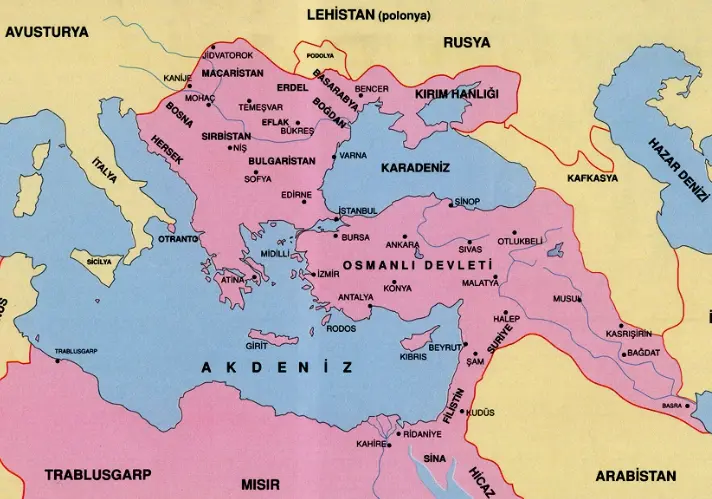“The Reasons for the Short Growth of the Ottoman Empire” is an important topic that has attracted the attention of many researchers and historians throughout history. The Ottoman Empire, after being founded as a small principality in the late 13th century, quickly became a great empire. This rapid growth can be explained by various factors such as military successes, effective governance, strategic marriages and diplomatic skills. “The Reasons for the Short Growth of the Ottoman Empire” is not only a historical phenomenon, but also of great importance in terms of understanding the place and influence of the Ottoman Empire in world history. In this article, we will examine in detail this extraordinary growth process of the Ottoman Empire and examine how the empire came to dominate such a wide geography in such a short time.
Reasons for the Short-Term Growth of the Ottoman Empire: Geographical Location and Strategic Advantages
Located in the Center of Anatolia
One of the most important reasons for the rapid growth of the Ottoman Empire was its strategic geographical location. The Ottoman Principality, located in the middle of the Anatolian Peninsula, had the advantage of controlling trade routes thanks to its proximity to both the European and Asian continents. This situation paved the way for the establishment of a powerful state structure economically and militarily.
Control of Trade Routes
The Ottomans increased their economic power by capturing strategic regions where important trade routes passed. With the conquest of Istanbul, the Ottomans gained control of important trade routes such as the Silk Road and the Spice Road, thus gaining great income and becoming economically stronger. This economic power enabled the further development of military and administrative structures.
Military Power and the Policy of Conquest
Janissary Corps and Professional Army
One of the most important factors in the rapid growth of the Ottoman Empire was having a strong and disciplined army. The Ottomans, who gained a professional army structure with the establishment of the Janissary Corps, quickly conquered large areas of land thanks to their regular and effective military forces. The success of the Janissaries on the battlefield allowed the Ottomans to successfully carry out their conquest policies.
Conquests and Territorial Gains
The policies of conquest followed by the Ottoman Empire also played an important role in its growth process. The Ottomans expanded their territory by making rapid and effective conquests in the Balkans and Anatolia. These conquests were made possible by both military successes and the support of the local people. The Ottomans’ just and tolerant approach to governance enabled the people in the conquered regions to easily adapt to Ottoman rule.

Management and Administrative Structure
Central Government and State Bureaucracy
Another factor that was effective in the rapid growth of the Ottoman Empire was that it had a strong and centralized administrative structure. The Ottomans adopted a centralized administrative approach and effectively controlled all regions of the state. The state bureaucracy was established based on merit and thus the state was governed by talented and experienced administrators.
Policy of Justice and Tolerance
Another important reason for the success of the Ottoman Empire was its understanding of government based on justice and tolerance. The Ottomans followed a tolerant policy towards different religions and nations in the regions they conquered. This increased the trust of the local people in the Ottoman government and helped prevent rebellions. The Ottoman justice system also attracted attention with its structure that protected the rights of the people and provided a fair administration.
Economic Power and Trade
Tax System and Revenue Sources
Economic power also played an important role in the rapid growth of the Ottoman Empire. The Ottomans increased state revenues by establishing an effective tax system. Taxes collected from lands, income from control of trade routes, and war spoils constituted the main sources of income for the Ottoman economy. These revenues contributed to the strengthening of military and administrative structures and the growth of the state.
Trade and Economic Policies
The Ottoman Empire achieved growth in a short time with the policies it followed in the fields of trade and economy. The Ottomans established safe and regular trade routes for the development of trade. In addition, various privileges were granted to merchants and tax relief was provided in order to encourage trade. This situation led to the revival of trade in Ottoman lands and the acceleration of economic growth.
Cultural and Social Structure
Education and Science
Developments in education and science also played an important role in the rapid growth of the Ottoman Empire. The Ottomans strengthened the education system through madrasahs and gave great importance to scientific studies. This contributed to the cultural and scientific development of Ottoman society and accelerated the modernization process of the state.
Art and Architecture
The Ottoman Empire also achieved significant success in the field of art and architecture. Ottoman architecture attracted attention especially with structures such as mosques, palaces and bridges. These structures symbolized the power and magnificence of the Ottoman Empire and also contributed to the cultural development of society.
Foreign Relations and Diplomacy
Strategic Marriages and Alliances
The Ottoman Empire’s success in foreign relations and diplomacy also played a major role in its rapid growth. The Ottomans increased their power through strategic marriages and alliances. These marriages and alliances strengthened the Ottoman Empire’s relations with neighboring states and changed the political balance in the region in its favor.
Diplomatic Skills and Agreements
Ottoman diplomats carried out effective diplomacy to protect and expand the interests of the state. The Ottomans gained an advantage over their enemies through strategic agreements and diplomatic maneuvers. This contributed to the rapid growth of the Ottoman Empire and allowed it to gain a strong position in the international arena.
In conclusion, “The Reasons for the Short-Term Growth of the Ottoman Empire” can be explained by the combination of many different factors. Elements such as strategic geographical location, strong military structure, centralized administration, economic power, cultural development and effective diplomacy played an important role in the Ottoman Empire becoming a great empire in a short time. In this article, we have examined in detail the reasons for the short-term growth of the Ottoman Empire. “The Reasons for the Short-Term Growth of the Ottoman Empire”, as a historical fact, is of great importance in terms of understanding the place and influence of the Ottoman Empire in world history. This rapid growth process of the Ottoman Empire has attracted the attention of many researchers and historians throughout history and many studies have been conducted on this subject. Understanding the reasons for the short-term growth of the Ottoman Empire is of critical importance in terms of grasping the dynamics behind the empire’s success.
